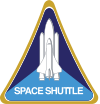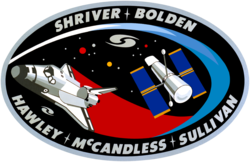STS-41
| Missionsemblem | |||||
|---|---|---|---|---|---|
 | |||||
| Missionsstatistik | |||||
| Missionsnavn: | STS-41 | ||||
| Rumagentur: | NASA | ||||
| Rumfærge: | Discovery (11) | ||||
| Antal besætningsmedlemmer: | 5 | ||||
| Affyringsrampe: | LC-39B (KSC) | ||||
| Opsendelse: | 6. oktober 1990 | ||||
| Landing: | 10. oktober 1990 | ||||
| Landet på: | Edwards Air Force Base | ||||
| Varighed: | 4 dage, 2 timer | ||||
| Foto af besætningen | |||||
 | |||||
| Navigation | |||||
| |||||

Denne artikel handler om en mission i rumfærge-programmet. For informationer om programmet se rumfærge-programmet.
STS-41 (Space Transportation System-41) var Discoverys 11. rumfærge-mission der blev opsendt d. 6. oktober 1990 og vendte tilbage den d. 10. oktober 1990.
Hovedformålet med missionen var at sætte Ulysses i kredsløb.
Besætning

 Richard Richards (kaptajn)
Richard Richards (kaptajn)
 Robert Cabana (pilot)
Robert Cabana (pilot)
 William Shepherd (1. missionsspecialist)
William Shepherd (1. missionsspecialist)
 Bruce Melnick (2. missionsspecialist)
Bruce Melnick (2. missionsspecialist)
 Thomas Akers (3. missionsspecialist)
Thomas Akers (3. missionsspecialist)
Missionen
Hovedartikler:
Eksterne henvisninger
- STS-41 NASA (engelsk)
- Ulysses Arkiveret 2. juni 2002 hos Wayback Machine NASA (engelsk)
| ||||||||
| ||||||||||||||||||||
| Wikimedia Commons har medier relateret til: |
Medier brugt på denne side
STS-41 Mission Insignia
The 5 member crew of the STS-41 mission included (left to right): Bruce E. Melnick, mission specialist 2; Robert D. Cabana, pilot; Thomas D. Akers, mission specialist 3; Richard N. Richards, commander; and William M. Shepherd, mission specialist 1. Launched aboard the Space Shuttle Discovery on October 6, 1990 at 7:47:15 am (EDT), the primary payload for the mission was the ESA built Ulysses Space Craft made to explore the polar regions of the Sun. Other main payloads and experiments included the Shuttle Solar Backscatter Ultraviolet (SSBUV) experiment and the INTELSAT Solar Array Coupon (ISAC).
SVG version of PNG Space Shuttle Logo/Patch.
Ulysses spacecraft and its upper stage system are deployed during STS-41.
- The Ulysses spacecraft and its upper stage system consisting of a two-stage inertial upper stage (IUS) (gold-colored with rocket nozzle visible) and the payload assist module-Shuttle (PAM-S) (middle section) drift against the blackness of space after deployment from Discovery's, Orbiter Vehicle (OV) 103's, payload bay (PLB) during STS-41. The airborne support equipment (ASE) extending from the spacecraft at the PAM-S/IUS mating interface is visible.
- The photo was made with a handheld Roliflex camera using 120 film.
The Space Shuttle Discovery hurtles into space as sister ship Columbia looks on from Launch Pad 39A. Discovery lifted off from pad 39B at 7:47 a.m. EDT, Oct. 6. Columbia will be moved to the vacated pad 39B where it will undergo testing to pinpoint the source of a liquid hydrogen leak. Discovery is carrying a crew of five and the Ulysses solar explorer as it embarks on mission STS-41, a four-day flight.
STS-38 Mission Insignia
STS-31 shuttle mission flight insignia. The mission insignia for NASA's STS-31 mission features the Hubble Space Telescope (HST) in its observing configuration against a background of the universe it will study. The cosmos includes a stylistic depiction of galaxies in recognition of the contribution made by Sir Edwin Hubble to our understanding of the nature of galaxies and the expansion of the universe. The STS-31 crew points out that is it in honor of Hubble's work that this great observatory in space bears his name. The depicted Space Shuttle trails a spectrum symbolic of both the red shift observations that were so important to Hubble's work and new information which will be obtained with the HST. Encircling the art work, designed by the crew, are the names of its members.
Rare view shows two space shuttles on adjacent Kennedy Space Center (KSC) Launch Complex (LC) 39 pads with the Rotating Service Structures (RSS) retracted. STS-35 Columbia, Orbiter Vehicle (OV) 102, is on Pad A (foreground) and being readied for a September 6 early morning launch, while its sister spaceship, Discovery, OV-103, is prepared for an October liftoff on Mission STS-41. View provided by KSC with alternate number KSC-90PC-1268. Also see S90-48904 for a similar view with alternate KSC number KSC-90PC-1269.
Forfatter/Opretter: Kwamikagami, Licens: CC BY-SA 4.0
symbol of Mars. 16 × 16 pixel nominal dimensions, lines 2 pixel thick, square caps. Colour 75% blue: red=0 green=0 blue=191 (#0000BF).
Rotated and color enhanced version of original (ISS013-E-48788 (6 July 2006) --- The Space Shuttle Discovery approaches the International Space Station for docking but before the link-up occurred, the orbiter "posed" for a thorough series of inspection photos. Leonardo Multipurpose Logistics Module can be seen in the shuttle's cargo bay. Discovery docked at the station's Pressurized Mating Adapter 2 at 9:52 a.m. CDT, July 6, 2006.)
















